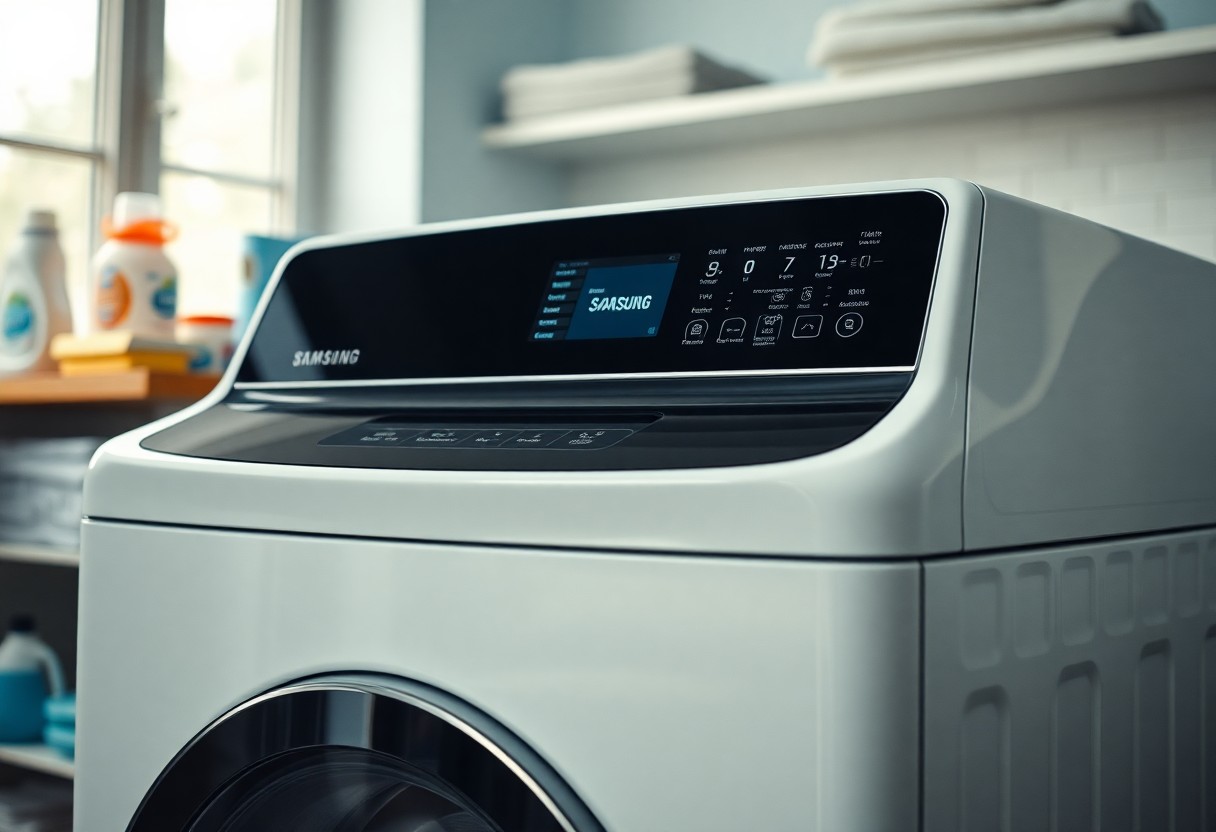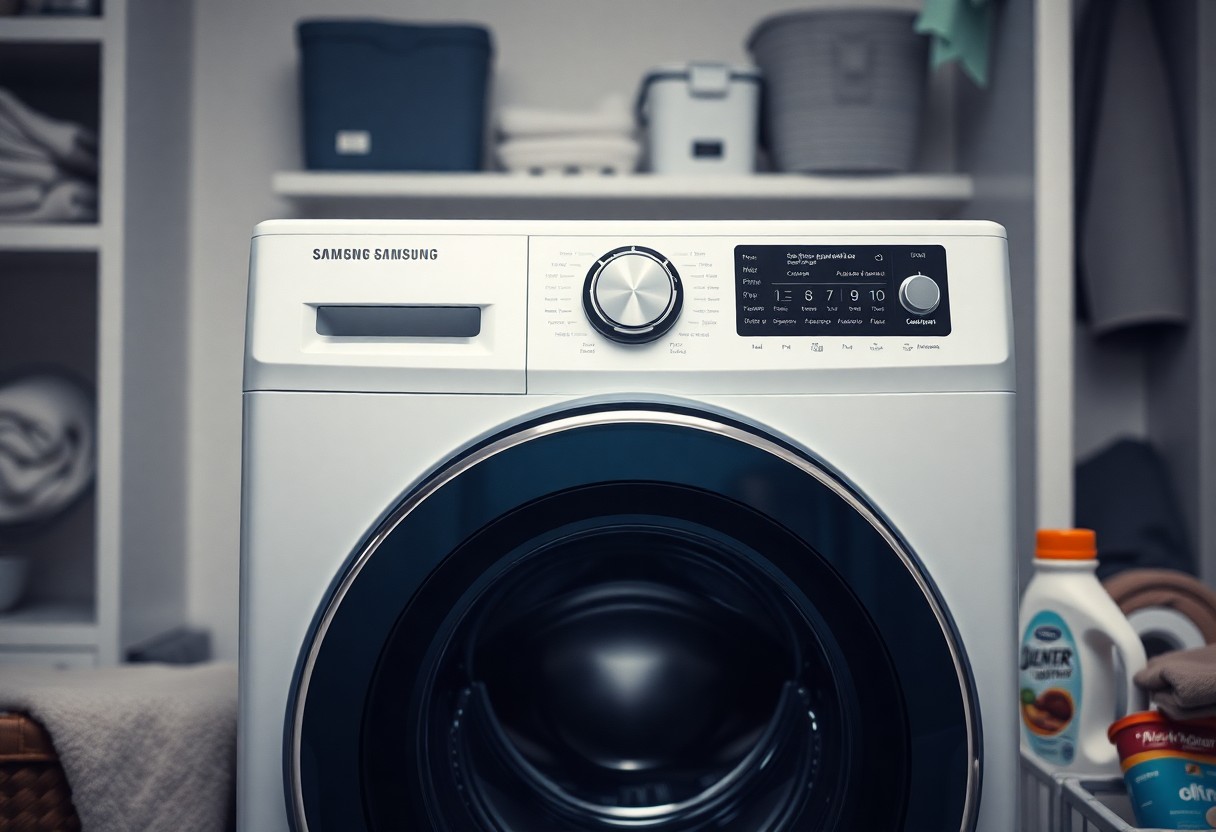Washing machine calibration is necessary for ensuring your Samsung top load washer operates at peak efficiency. By learning how to calibrate your machine, you can enhance its performance and prolong its lifespan. This straightforward process helps maintain precise load sensing and water levels, offering better cleaning results. Following the steps outlined in this guide will ensure you get the most out of your appliance, keeping your laundry not only clean but done safely and effectively.
Key Takeaways:
- Ensure the washing machine is level before starting the calibration process, as an unlevel machine can affect its performance and accuracy.
- Activate the calibration mode by following the specific sequence outlined in the user manual, which typically involves selecting certain cycle buttons in a specified order.
- After calibration, run a test load to confirm that the washing machine is operating correctly and efficiently, making further adjustments if necessary.
Understanding Calibration
While calibrating your Samsung top load washing machine may seem daunting, it is an crucial process that ensures your appliance operates efficiently. Proper calibration helps maintain optimal performance, reduces energy consumption, and prolongs the lifespan of your machine. By understanding the calibration process, you can troubleshoot any issues and improve your washing experience.
What is Calibration?
On a washing machine, calibration refers to the adjustment of its settings to align with the manufacturer’s specifications. This process ensures that the machine correctly measures load size, water levels, and cycle times. By calibrating your machine, you can achieve consistent wash results and maintain the integrity of your clothing.
Importance of Proper Calibration
The importance of proper calibration in your washing machine cannot be overstated. An improperly calibrated machine can lead to inefficient cleaning, increased energy bills, and even potential damage to your clothes. Additionally, failing to calibrate can result in overflows or underfill issues that can compromise your laundry routine. By ensuring your machine is correctly calibrated, you are not only enhancing performance but also extending its operational life.
What you may not realize is that proper calibration impacts both the effectiveness and safety of your appliance. Without calibration, you risk inconsistent wash cycles: clothes may come out dirty or damaged, increasing your laundry workload. Furthermore, machines that are not correctly calibrated might use excess water and energy, leading to higher utility costs. By taking the time to calibrate your washing machine, you can ensure better washing outcomes and protect your investment.

Factors Affecting Calibration
You should be aware that several factors can significantly influence the calibration of your Samsung top load washing machine. Key elements include:
- Load size
- Detergent type
- Water temperature
- Cycle selection
Assume that not accounting for these factors can result in suboptimal performance and inefficient washing results.
Load Size
Assuming you overload or underload your washing machine, you may have difficulties with calibration. The machine operates best within a specific weight range; hence, ensuring the right load size can significantly enhance washing efficiency.
Detergent Type
Now, the type of detergent you choose directly affects how well your washing machine performs. Using the appropriate detergent helps in achieving the best cleaning results, while the wrong type may hinder efficiency.
It is necessary to opt for high-efficiency detergents designed specifically for your washing machine. These detergents create fewer suds, ensuring optimal performance. On the other hand, using regular detergents may cause excess suds, leading to malfunctions or damage over time. Select a detergent that’s compatible with your machine and follow the manufacturer’s recommendations for proper dosage to keep your machine functioning effectively.

How-to Steps for Calibration
Once again, calibrating your Samsung top load washing machine is necessary to ensure it operates efficiently. Begin by following these clear steps carefully, as they will help you achieve accurate calibration results and enhance the performance of your machine.
Preparing the Washing Machine
Even before you start the calibration process, you need to prepare your washing machine by ensuring it is level and clean. Check for any foreign objects in the drum, and make sure the water supply hoses are securely connected. This preparation eliminates distractions during calibration.
Performing the Calibration Procedure
The next step is to execute the calibration procedure on your Samsung washing machine. You will need to access the control panel and follow the specific buttons prompts to engage the calibration mode.
Procedure: To commence the calibration, turn on your washing machine and press the appropriate button sequence to enter diagnostic mode. Often, this involves pressing the ‘spin’ and ‘power’ buttons simultaneously. Once in diagnostic mode, your washer will go through a series of test cycles to measure both agitation and spin performance. Watch closely for any error codes. If the machine operates smoothly, it confirms successful calibration. If issues arise, make sure to check your water supply and drainage systems. A well-calibrated machine enhances wash performance and prolongs its lifespan.
Tips for Successful Calibration
Unlike many people think, calibrating your Samsung Top Load Washing Machine efficiently requires attention to detail. Utilize these tips for success:
- Ensure the machine is level.
- Run a calibration cycle without any laundry.
- Keep the door closed during the calibration.
- Follow the manufacturer’s instructions closely.
Assume that these steps will enhance the accuracy of your washing machine’s performance.
Regular Maintenance Recommendations
Maintenance of your washing machine is important for optimal performance. Schedule periodic cleaning of the drum, filters, and detergent dispenser to keep your Samsung Top Load Washing Machine running smoothly. Regular checks for any leaks or unusual noises will also help you identify potential problems early, preventing costly repairs down the line.
Common Mistakes to Avoid
While calibrating your Samsung Top Load Washing Machine, it’s easy to make mistakes that could affect the process. To achieve accurate calibration, avoid these pitfalls: not leveling the machine properly can lead to incorrect readings, while skipping the calibration cycle can hinder performance. Additionally, failing to close the lid during calibration might cause your machine to get stuck in a cycle. Keeping up with these small details can significantly improve your washing experience and prevent inefficiencies.
Troubleshooting Calibration Issues
After attempting to calibrate your Samsung top load washing machine, you might encounter some calibration issues. These problems can affect the efficiency and effectiveness of your machine, leading to unsatisfactory washing results. If you notice changes in cycle times or load sensing, it’s important to address these issues promptly to ensure your washing machine operates at its best.
Identifying Calibration Problems
On closer inspection, you might notice symptoms that signal calibration problems in your washing machine, such as excessive vibration, inconsistent filling, or failure to switch cycles. These indicators can suggest that your machine is not properly calibrated and requires immediate attention. A swift diagnosis will help you in resolving these concerns before they escalate.
Solutions for Common Issues
Common issues such as unbalanced loads, incorrect water levels, and irregular cycle durations can usually be resolved with a few adjustments. Start by ensuring that your load is evenly distributed in the drum to minimize vibrations. If you find the machine is not filling adequately, check your water supply and ensure the inlet valves are functioning correctly.
Understanding the underlying causes of these common issues is key to restoring your machine’s functionality. If your washing machine exhibits persistent symptoms like not filling to the correct level, it may indicate a problem with the water inlet valve, which requires examination or replacement. Additionally, if you notice the machine struggles to reach the end of cycles, this can stem from drainage clogs or sensor malfunctions. Addressing these concerns promptly can prevent further complications and enhance your washer’s performance.
Conclusion
Summing up, calibrating your Samsung top load washing machine is important for optimal performance and efficiency. By following the outlined steps—ensuring your machine is level, accessing the calibration mode, and running the calibration cycle—you can ensure that your washer functions correctly. Regular calibration helps protect your laundry and prolongs the life of your appliance, allowing you to enjoy cleaner clothes with less hassle. Don’t hesitate to refer back to the calibration guide whenever necessary to maintain your washing machine in top condition.
FAQ
Q: Why is it important to calibrate a Samsung top load washing machine?
A: Calibrating your Samsung top load washing machine ensures that it accurately measures water levels, washing cycles, and spin speeds. This process helps maintain the efficiency of the machine and improves washing performance, leading to cleaner clothes and optimal use of energy and water.
Q: How do I know if my washing machine needs calibration?
A: Signs that your washing machine may require calibration include inconsistent water levels (too much or too little), uneven loads during the spin cycle, or if specific cycles are taking longer than usual. If you notice any of these issues, it’s a good time to initiate the calibration process.
Q: What steps should I follow to calibrate my Samsung top load washing machine?
A: To calibrate your Samsung top load washing machine, follow these steps:
1. Start by emptying the washer and ensuring that it is level on the ground.
2. Power on the machine and select the ‘Calibration’ mode, which often can be accessed by pressing a specific combination of buttons (refer to your user manual for exact details).
3. Allow the machine to run through the calibration cycle, which usually lasts around a few minutes.
4. Once completed, check that the water levels are appropriate and monitor the performance during subsequent cycles.
Q: How often should I calibrate my washing machine?
A: It is advisable to calibrate your Samsung top load washing machine once a year or whenever you change the placement of the appliance, such as moving it to a different location. Additionally, consider recalibrating after experiencing any of the issues mentioned earlier, to ensure optimal machine operation.
Q: Where can I find the calibration instructions specific to my Samsung model?
A: Calibration instructions can usually be found in the user manual that came with your Samsung top load washing machine. If you don’t have the manual on hand, you can visit the Samsung support website, where you can enter your model number to access digital manuals and troubleshooting guides. This ensures you follow the correct procedures for your specific machine model.
